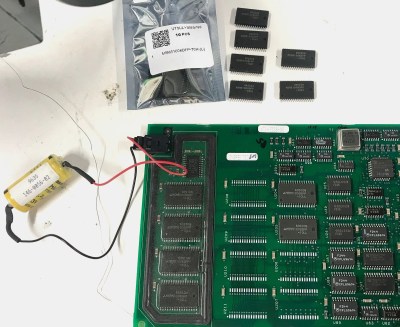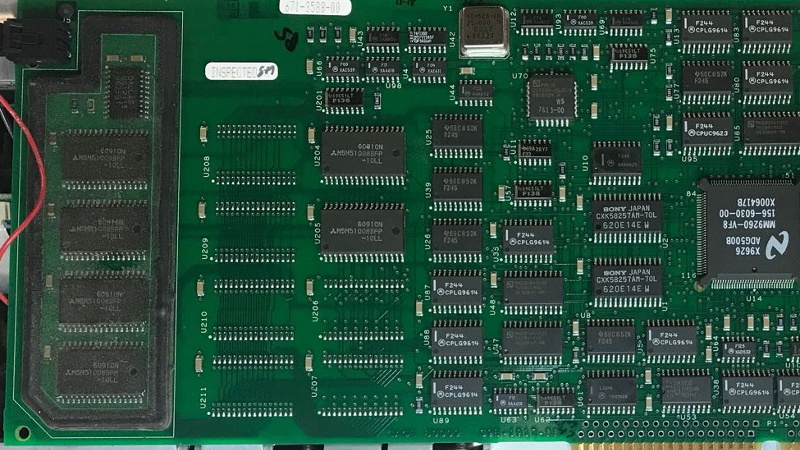From reading his extensive write-ups on the subject, there’s one thing we know for sure: [Tom Verbeure] loves his Tektronix TDS 420A oscilloscope. While it might be older than some of the people reading this, it’s still an impressive piece of hardware with more than enough bells and whistles to keep the average hacker occupied. Especially if you’re willing to perform some hardware modifications.

[Tom] already knew how to tickle the scope into unlocking software features, a process not unlike what we’ve seen done on more modern scopes. But there’s only so far you can get by toggling software flags.
Some of the more advanced features that are turned off in the firmware actually need additional hardware to function. Simply bumping the sample points to 120,000 in software wasn’t enough, the scope actually needs the memory to hold them in.
Now logically, if there’s a software option to increase the number of samples, there must be a hardware upgrade that goes along with it. Sure enough, [Tom] found there were 6 open spots next to the scope’s existing M5M51008 static RAM ICs.
As luck would have it the chips are still available, albeit from a different manufacturer and a bit faster than the original parts. Digikey wouldn’t sell fewer than 100 of them, but UTSource was happy to sell him 10. In this case, the parts were cheaper than the shipping cost. Installation was about as straightforward as it gets, though [Tom] does note that he had to keep the board powered up during the operation or else the scope would have lost its calibration data.
Squeezing more features out of modern scopes like the Rigol DS2072A just takes a USB cable and some software. Sometimes it’s only a matter of tapping in a code. But we certainly appreciate [Tom] putting in a little extra effort to get the most out of this classic piece of hardware.















I’m always amused by the fact that the back of every oscilloscope I’ve owned says “No user serviceable parts inside”
Seems like most oscilloscopes are used by people who service things. Also, they take statements like this as a personal challenge.
I know I would take it as such – nothing that has said that to me yet has avoided at least a curiosity satisfying partial tear down (probably as soon as I realise the warranty is expired). And many things have been at least bodged back together after they fail – I like a quality repair as much as anybody but some things are not worth the effort knowing the rest of the thing is far along the road to the recycling centre already.
That said the cost and time of dealing with such an old scope and upgrading it etc isn’t worth it to me. I’ve got too many other things I’m supposed to be doing to bring a required tool up to the minimum spec, and newer scopes with these features are not exactly bank breaking.
Got to love the amount of fun to be had in doing such a project. But I don’t think it would ever get onto my pile..
For many people $500 for a new scope is bank breaking.
True, but unless you get given or find the old scope even an old scope isn’t that cheap to buy. So its only an increase in cost of $100-300 say for the new one, but you have to put in lots of your time, and further money in parts to get it to do what you want..
Great fun, but unless its free….
“No user serviceable parts inside”, That’s not a warning, it’s a dare.
Ha. It’s a legal team that isn’t interested in any kind of reasoning or thought about what the product is for or who will use it; they just want to reduce liability.
Every oscilloscope I’ve owned came with a 2″ thick manual that included a detailed theory of operation, schematics, calibration instructions, and trouble-shooting steps. Tektronix manuals are part of the foundation of my electronics education.
I did quite a bit of googling to find schematic of the TDS 420A, but nothing turned up. That seems to be the case for most TDSxxx class Tek scopes unfortunately.
Service manuals, calibration instructions, and trouble-shooting steps are still downloadable from the Tektronix website though.
Nice.
If I did this, my first instinct would have been to pull the battery.
Then would have come the long and hairy road of trying to figure out where I screwed up…
+1, and it would be everyone else’s fault….
Cool project! 😎
Some people in the comments
Have a strange definition of “old”, though.
A digital scope from the 90s isn’t exactly old, IMHO.
Heck, a 486 PC running WfW and DOS didn’t even qualify as “vintage” until recently in many people’s eyes (though it’s now considered vintage).
For the record, I’m using an old 1MHz Trio osilloscope here – that I bought on purpose just a year ago! 😁
That’s an unit from the 1960s/70s..
While it’s technically old, would never look at it being old.
It’s just a “normal”, little oscilloscope.
Well they were calling 60s cars classic since the 80s, so that makes a 2000 Hyundai Tiburon a classic now.
Well, yes, sure. In this field that’s true. 🙂
Also in computing, which used to be very shortlived until the 2000s.
Since then, people are using their computers much longer.
Perhaps it’s just me, but I consider that a scope rather is like a long lived tool.
Like a screwdriver, a hammer or a amp/voltage meter or multimeter.
Or a morse key. Or a pair of good headphones. Or a Weller TCP24. 😉
In other words, it’s (almost timeless) . It’s functionality won’t suffer just because it’s an old model.
That doesn’t mean that it won’t need to be serviced from time to time, of course.
So as long as it is fixable, it has its place still.
Ps: Sorry for my poot English.
It’ s not my first language. 😅
Your poor English is quite good. Your “poot” English is rather funny. :) typos. ;)
Students getting their first practicals on using an oscilloscope from me get to use an old dual channel TRIO scope. If they can figure things out on these full analog beauties they get a digital one because I want them to understand the basic principles first. My personal scope is still an old Philips even though I have plenty of digital ones around
Personnally
I hate my digital scope, I can do and see more on my analog Techtronix scopes.
lot of interesting Tek mods / enhancements showing up these days.
Here is an interesting “hack” – a replacement for the failure prone U800 hybrid found in the 24xx scopes.
https://youtu.be/2FZGAFm1ESg
My first and only scope didn’t have any fancy memory, all it had were a few knobs to adjust the vertical and horizontal range and an electron gun! Admitidly my grandad gave it to me 30 years ago and no idea how long he had it first.
I went on ebay looking for this model and it still sells for something like $200. Any reason to not just pony up for a new Hantek / used Rigol at that price point?
I bought a pallet of oscilloscopes in varying states of working-ness from my old employer at a company auction… Paid 50 cents… One of the scopes was a TDS420A. It had taken a nosedive from a riser to the bench, and the BNC for channel 1 had bent, and cracked the ceramic input/attenuation module on the main analog board. I took the gamble on a for parts auction for another TDS420A on ebay. Description suggested a bad CPU board. I extracted a good module, repaired the analog board, and thanks to the calibration tools at my old employer, recalibrated the scope. Used it for a while, but ultimately, ended up selling it on ebay for $499. I sold the leftover parts unit I’d bought for $240 after spending $280 on it initially.
Also snagged a TDS320 from that 50 cent pallet. It’s only problem… “Burned in” screen… There was a thick coating of dust behind the plastic screen cover. Wiped it clean, and it was bright and clear again! Sold that one for $280.
That was a great auction! Hehe!
you suck!
(in other words, I’m jealous!)
B^)
I’ll one-up ya. I picked up a Lecroy WaveRunner 64xi that would not boot at the Tektronix company store for I think $270. All it had was a bad bios battery and a couple missing knobs. Replaced the battery and LeCroy sent me knobs for free. Rated for 600MHz and 10GS/s but will easily do 1GHz.
Kept that and sold off my TDS340 and 420.
You’re right: it’s probably not the best kind of investment.
The reason I bought it (for $190) was because I explicitly wanted a Tektronix scope for a different hobby project: adding support for Tek scope in glscopeclient.
Adding the options and the extra RAM was more about the journey than about the result: a great way to learn to about the internal of an oscilloscope, learn Ghidra etc.
I recently got a TDS 360, hoping for something in this article I could apply to mine, but turns out I already had those features enabled. For hobby work there’s nothing wrong with these old scopes, and they can be had for very cheap with the right amount of patience. “Sort by distance” and local pickup on ebay are your friend, since these are too heavy to ship economically.